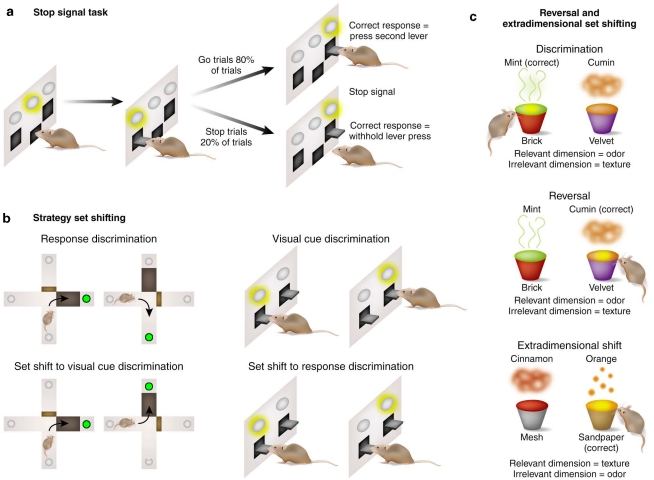Figure 3.
Diagrams of procedures used to assess different aspects of behavioral flexibility. (a) In the stop-signal task, rats begin each trial with a nose poke in the central food magazine. The go-phase trial begins with a left lever press and then the rat must move quickly to press the right lever to complete the ‘go' response. On 20% of trials, a stop-signal tone during the go-phase signals that the rat must inhibit the right lever press. Adapted from Eagle and Baunez (2010). (b) Strategy set-shifting tasks have been conducted on either a cross-maze (left) or operant chambers (right). On the maze, rats are initially trained to make a 90° right turn to receive food reinforcement. A visual cue is randomly placed in one of the choice arms on each trial, but do not reliably predict the location of food. During the set-shift, the rat is now required to use a visual-cue discrimination strategy, entering the arm with the visual cue, requiring either a right or left turn. Thus, the rat must shift from the old strategy and approach the previously irrelevant cue in order to obtain reinforcement. In the operant chamber, rats are initially trained on a visual-cue discrimination (upper panel), being required to always press the lever that had a stimulus light illuminated above it. For the set-shift to a response discrimination (lower panel), rats are trained to always press one of the levers (eg, left), regardless of the position of the cue light. (c) In the extradimensional shifting task, rats initially dig for food in one of two bowls that can be discriminated on the basis of odor, texture, or other attributes, with only one stimulus dimension being relevant initially (eg, odor, left). During reversal learning, the same stimuli are used, but the bowl that was previously un-reinforced now contains food (middle). During the critical extradimensional shift, new bowls are presented, and now the rat must discriminate based on the texture that surrounds the bowl, but not the odor (right).

